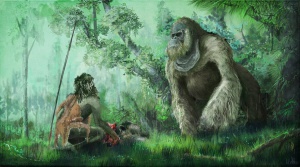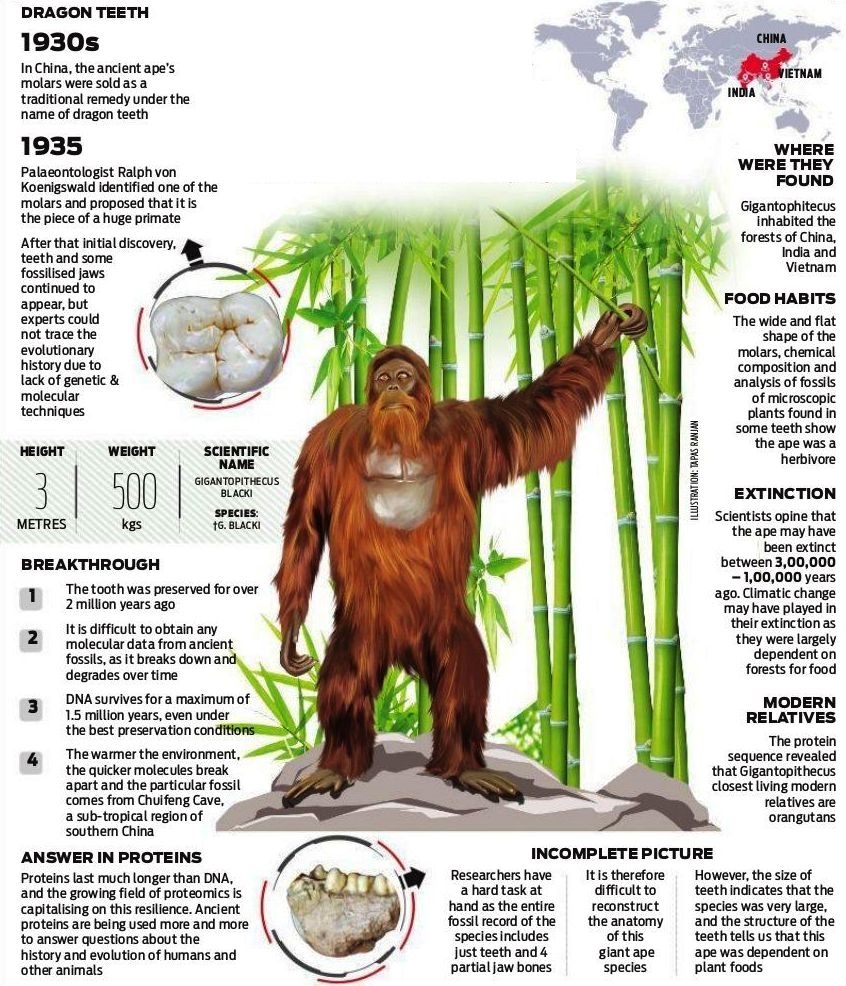Gigantopithecus blacki
Gigantopithecus blacki (Greek and Latin for "Black's giant ape") is an extinct species of ape.
The only known fossils of G. blacki, or "Giganto," are a few teeth and mandibles found in cave sites in Southeast Asia. As the name suggests, these are appreciably larger than those of living gorillas, but the exact size and structure of the rest of the body can only be estimated in the absence of additional findings. Recent research using high-precision absolute-dating methods has shown that after existing for about a million years, G. blacki died out as recently as 100,000 years ago. This means that it coexisted with (anatomically) modern humans (Homo sapiens) for a few dozen thousands of years, and with the most immediate ancestors of H. sapiens before that.
Based on the fossil evidence, paleontologists speculate that Gigantopithecus had an adult standing height of over three meters (ten feet) and a weight of 550 kg (1200 lb), and was thus much larger and heavier than current-day gorillas.
The species lived in Asia and probably inhabited bamboo forests, since its fossils are often found alongside those of extinct ancestors of the panda. Most evidence points to Gigantopithecus being a plant-eater. Some believe that being a plant-eating species, G. blacki was placed at the losing end of the evolutionary competition with humans.
Its appearance is not known, because of the fragmentary nature of its fossil remains. It is possible that it resembled modern gorillas, because of its supposedly similar lifestyle. Some scientists, however, think that it probably looked more like its closest modern relative, the orangutan. Being so large, it is possible that Gigantopithecus had few or no enemies when fully grown; however, younger, weak or injured individuals may have been vulnerable to tiger and Homo erectus attacks.
The species' method of locomotion is uncertain, as no pelvic or leg bones have been found. The dominant view is that it walked on all fours like modern gorillas and chimpanzees. However, a minority opinion favors bipedal locomotion, most notably as championed by the late Grover Krantz. It should be noted that this assumption is based only on the very few jawbone remains found, all of which are U-shaped and widen towards the rear. This widening, in Krantz's view, allowed room for the windpipe to be positioned within the jaw, allowing the skull to sit squarely upon a fully-erect spine like modern humans, rather than roughly behind it, like the great apes
Gigantopithecus blacki and Bigfoot
Dr. Grover Krantz was the most vocal supporter of the theory that Gigantopithecus blacki traversed the ice bridge from Asia to North America and exists today as the creature known as bigfoot.
Due to the likelihood that G. blacki co-existed with anatomically modern H. sapiens, it is possible that encounters with the creatures over a hundred thousand years ago may have become, through oral tradition, the legends about the yeti or bigfoot still passed around today.

